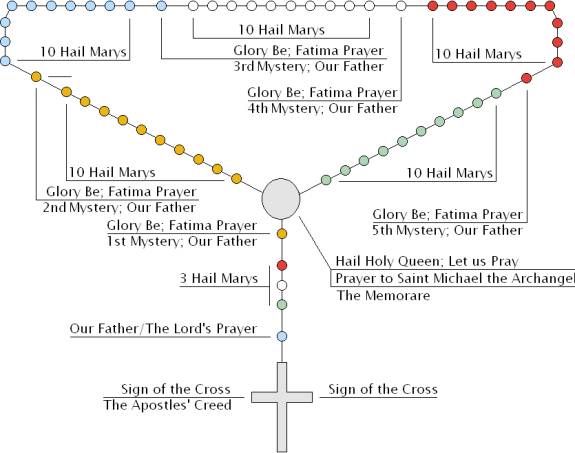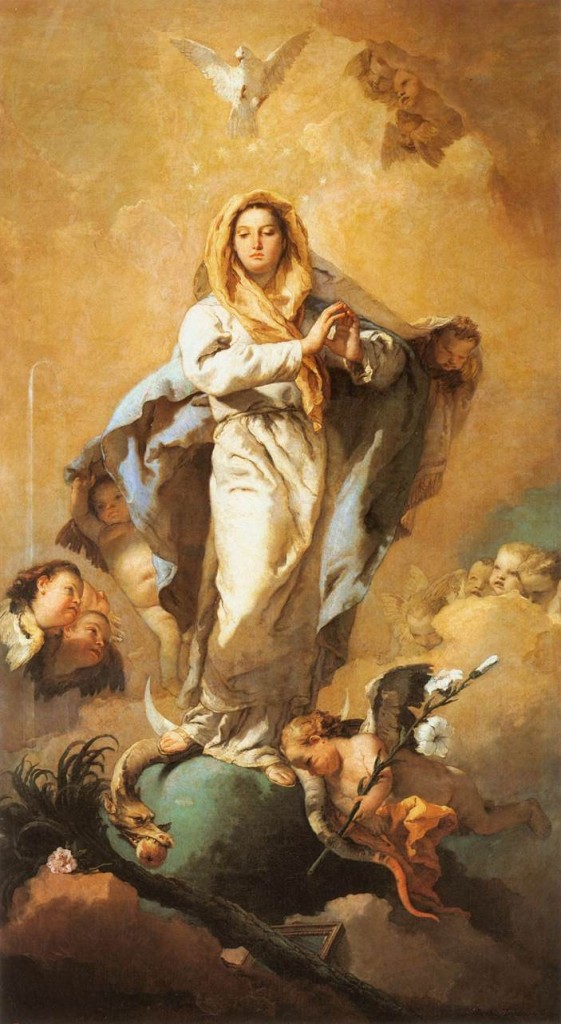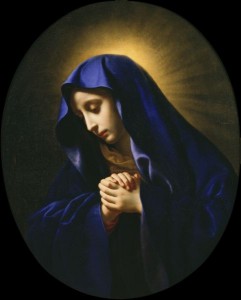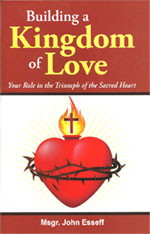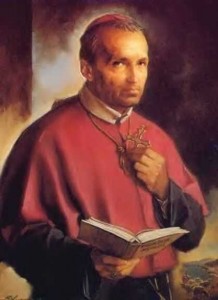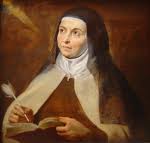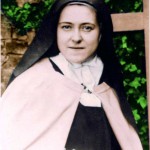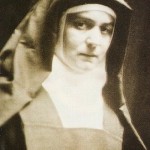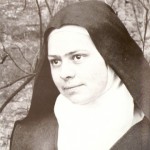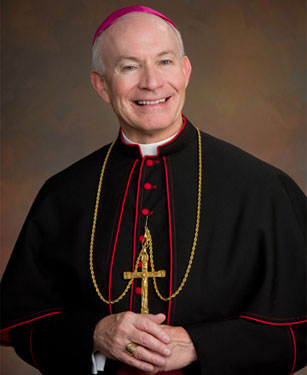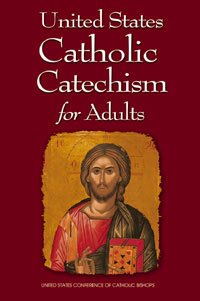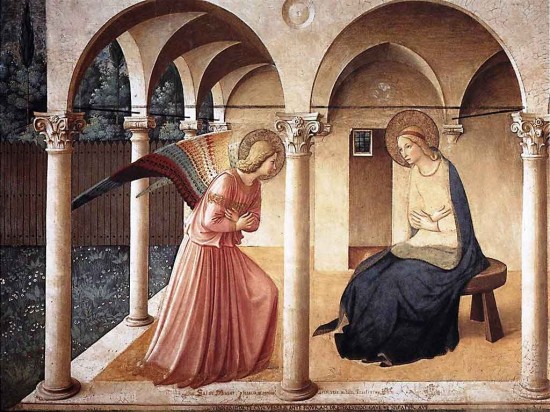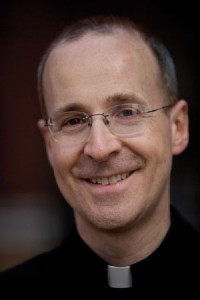
Join Bruce and I, as we discuss the life of both St. Maximilian Kolbe and St. Teresa Benedicta of the Cross with Fr. James Martin, S.J.
[powerpress]
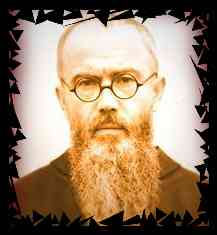 Just look at his eyes…every picture of St. Maximillan Kolbe has those fiery prophetic eyes.
Just look at his eyes…every picture of St. Maximillan Kolbe has those fiery prophetic eyes.
Fueled with the fires of grace from his great love for and devotion to the Blessed Virgin Mary, St. Maximilian was a missionary extraordinaire. A publisher who was a leader in the yet to be defined “New Evangelization”.
They say the blood of the martyrs becomes the seed for the Church. In the case of St. Maximilian, Catholic publishing and broadcasting…all media, would be enriched by his intercession and example. His courage in speaking out against the horrors of the Nazi regime is what placed him in the death camp; it would be his love for Christ and his neighbor that would lead him to give his life for another. And that is what earned him the martyr’s crown.
“In order to discourage escapes, Auschwitz had a rule that if a man escaped, ten men would be killed in retaliation. In July 1941 a man from Kolbe’s bunker escaped. The dreadful irony of the story is that the escaped prisoner was later found drowned in a camp latrine, so the terrible reprisals had been exercised without cause. But the remaining men of the bunker were led out.
‘The fugitive has not been found!’ the commandant Karl Fritsch screamed. ‘You will all pay for this. Ten of you will be locked in the starvation bunker without food or water until they die.’ The prisoners trembled in terror. A few days in this bunker without food and water, and a man’s intestines dried up and his brain turned to fire.
The ten were selected, including Franciszek Gajowniczek, imprisoned for helping the Polish Resistance. He couldn’t help a cry of anguish. ‘My poor wife!’ he sobbed. ‘My poor children! What will they do?’ When he uttered this cry of dismay, Maximilian stepped silently forward, took off his cap, and stood before the commandant and said, ‘I am a Catholic priest. Let me take his place. I am old. He has a wife and children.’
Astounded, the icy-faced Nazi commandant asked, ‘What does this Polish pig want?’
Father Kolbe pointed with his hand to the condemned Franciszek Gajowniczek and repeated‘I am a Catholic priest from Poland; I would like to take his place, because he has a wife and children.’
Observers believed in horror that the commandant would be angered and would refuse the request, or would order the death of both men. The commandant remained silent for a moment. What his thoughts were on being confronted by this brave priest we have no idea. Amazingly, however, he acceded to the request. Apparantly the Nazis had more use for a young worker than for an old one, and was happy to make the exchange. Franciszek Gajowniczek was returned to the ranks, and the priest took his place.
Gajowniczek later recalled:
 I could only thank him with my eyes. I was stunned and could hardly grasp what was going on. The immensity of it: I, the condemned, am to live and someone else willingly and voluntarily offers his life for me – a stranger. Is this some dream?
 I was put back into my place without having had time to say anything to Maximilian Kolbe. I was saved. And I owe to him the fact that I could tell you all this. The news quickly spread all round the camp. It was the first and the last time
For that such an incident happened in the whole history of Auschwitz. A long time I felt remorse when I thought of Maximilian. By allowing myself to be saved, I had signed his death warrant. But now, on reflection, I understood that a man like him could not have done otherwise. Perhaps he thought that as a priest his place was beside the condemned men to help them keep hope. In fact he was with them to the last.’‘
A personal testimony about the way Maximilian Kolbe met death is given by Bruno Borgowiec, one of the few Poles who were assigned to render service to the starvation bunker. He told it to his parish priest before he died in 1947:
 ‘The ten condemned to death went through terrible days. From the underground cell in which they were shut up there continually arose the echo of prayers and canticles. The man in-charge of emptying the buckets of urine found them always empty. Thirst drove the prisoners to drink the contents. Since they had grown very weak, prayers were now only whispered. At every inspection, when almost all the others were now lying on the floor, Father Kolbe was seen kneeling or standing in the centre as he looked cheerfully in the face of the SS men.
Father Kolbe never asked for anything and did not complain, rather he encouraged the others, saying that the fugitive might be found and then they would all be freed. One of the SS guards remarked: this priest is really a great man. We have never seen anyone like him ..
Two weeks passed in this way. Meanwhile one after another they died, until only Father Kolbe was left. This the authorities felt was too long. The cell was needed for new victims. So one day they brought in the head of the sick-quarters, a German named Bock, who gave Father Kolbe an injection of carbolic acid in the vein of his left arm. Father Kolbe, with a prayer on his lips, himself gave his arm to the executioner. Unable to watch this I left under the pretext of work to be done. Immediately after the SS men had left I returned to the cell, where I found Father Kolbe leaning in a sitting position against the back wall with his eyes open and his head drooping sideways. His face was calm and radiant ..’
 So it was that Father Maximilian Kolbe was executed on 14 August, 1941 at the age of forty-seven years, a martyr of charity. The death certificate, as always made out with German precision, indicated the hour of death 12.30.
Father Kolbe’s body was removed to the crematorium, and without dignity or ceremony was disposed of, like hundreds of thousands who had gone before him, and hundreds of thousands more who would follow.
The heroism of Father Kolbe went echoing throughAuschwitz. In that desert of hatred he had sown love. A survivor Jozef Stemler later recalled: ‘In the midst of a brutalization of thought, feeling and words such as had never before been known, man indeed became a ravening wolf in his relations with other men. And into this state of affairs came the heroic self-sacrifice of Father Kolbe.’ Another survivor Jerzy Bielecki declared that Father Kolbe’s death was ‘a shock filled with hope, bringing new life and strength … It was like a powerful shaft of light in the darkness of the camp.’
The cell where Father Kolbe died is now a shrine. Maximilian Kolbe was beatified as Confessor by Paul VI in 1970, and canonized as Martyr by Pope John Paul II in 1981.†– from St. Maximillian Kolbe, saint of Auschwitz
Tags: auschwitz, blessed virgin mary, catholic, catholic podcast, catholic prayer, catholic priest, cathollc spirituality, children, edith stein, father kolbe, fr. james martin, holacaust, James Martin, martyrs, maximillan kolbe, Maximillian Kolbe, nazi death camp, st maximilian
This entry was posted on Thursday, August 14th, 2014 at 6:01 pm
You can follow any responses to this entry through the RSS 2.0 feed.
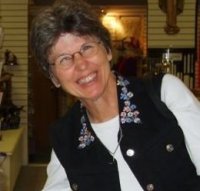
Teresa Monaghen, of Pro Sanctity and Fr. John Sianchuck, C.Ss.R., a Ukranian Byzantine priest do a great job of explaining the Western and Eastern understanding of this great mystery.
Take a listen to the discussion posted above, that Bruce and I had with Teresa Monaghen, from Pro Sanctity and Fr. John Sianchuk, C.Ss.R., a Ukrainian Redemptorist priest discuss the difference and similarities of Western and Eastern understanding of the Immaculate Conception of the Blessed Virgin Mary
[powerpress]
From the Catechism of the Catholic Church on the Immaculate Conception,Â
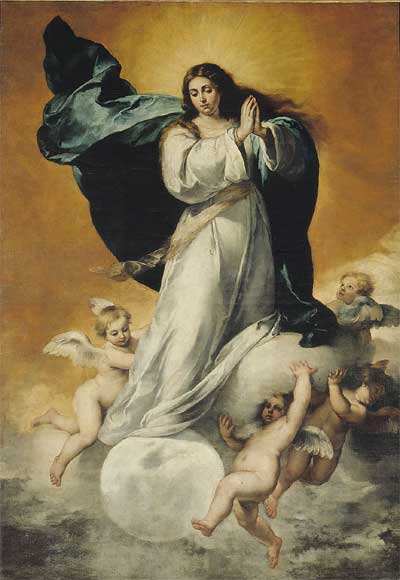 “490 To become the mother of the Savior, Mary “was enriched by God with gifts appropriate to such a role.”132 The angel Gabriel at the moment of the annunciation salutes her as “full of grace”.133 In fact, in order for Mary to be able to give the free assent of her faith to the announcement of her vocation, it was necessary that she be wholly borne by God’s grace.
“490 To become the mother of the Savior, Mary “was enriched by God with gifts appropriate to such a role.”132 The angel Gabriel at the moment of the annunciation salutes her as “full of grace”.133 In fact, in order for Mary to be able to give the free assent of her faith to the announcement of her vocation, it was necessary that she be wholly borne by God’s grace.
491 Through the centuries the Church has become ever more aware that Mary, “full of grace” through God,134 was redeemed from the moment of her conception. That is what the dogma of the Immaculate Conception confesses, as Pope Pius IX proclaimed in 1854:
- The most Blessed Virgin Mary was, from the first moment of her conception, by a singular grace and privilege of almighty God and by virtue of the merits of Jesus Christ, Savior of the human race, preserved immune from all stain of original sin.135
 492 The “splendor of an entirely unique holiness” by which Mary is “enriched from the first instant of her conception” comes wholly from Christ: she is “redeemed, in a more exalted fashion, by reason of the merits of her Son”.136 The Father blessed Mary more than any other created person “in Christ with every spiritual blessing in the heavenly places” and chose her “in Christ before the foundation of the world, to be holy and blameless before him in love”.137
493 The Fathers of the Eastern tradition call the Mother of God “the All-Holy” (Panagia), and celebrate her as “free from any stain of sin, as though fashioned by the Holy Spirit and formed as a new creature”.138 By the grace of God Mary remained free of every personal sin her whole life long. ”
  This video does a nice job of tracking the history of the dogma
Tags: angel gabriel, ark of the covenant, blessed virgin mary, catechism of the catholic church, dogma of the immaculate conception, eastern tradition, immaculate conception, John Sianchuk, mary full of grace, mother of god, new ark, new creature, pope pius ix, sin, singular grace, teresa monaghen
This entry was posted on Monday, December 9th, 2013 at 12:08 am
You can follow any responses to this entry through the RSS 2.0 feed.
CW4 Our Lady of the Rosary – Praying with the Blessed Virgin Mary – The  Great Cloud of Witnesses: Guides for Prayer with Fr. Mark Cyza
Great Cloud of Witnesses: Guides for Prayer with Fr. Mark Cyza
[powerpress]
Fr. Mark Cyza discusses praying with Our Lady of the Holy Rosary. Â He speaks of the history of the devotion., as well as, Â the importance of spending time in contemplation of the saving mysteries of our salvation. Â Fr. Cyza explains why should welcome the opportunity to pray with Blessed Virgin Mary and how she walks with us in her great garden of prayer.
Resources:
 Visit the
Visit the
Discerning Hearts
Holy Rosary Page
here
Tags: blessed virgin mary, contemplation, Mark Cyza, mysteries, prayer
This entry was posted on Saturday, October 12th, 2013 at 3:05 pm
You can follow any responses to this entry through the RSS 2.0 feed.
“For with God nothing will be impossible”
[powerpress]
an excerpt from today’s reflection by Don Schwager: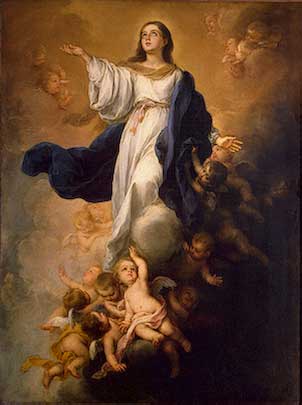
What is the key that can unlock the power and grace of God’s kingdom in our personal lives? Faith and obedience for sure! When Adam and Eve disobeyed God, they immediately experienced the consequence of their action – separation from the God who loved them. God in his mercy promised them a Redeemer who would pay the price for their sin and the sin of the world. We see the marvelous unfolding of God’s plan of redemption in the events leading up to the Incarnation, the birth of the Messiah. Mary’s prompt response of “yes” to the divine message is a model of faith for all believers. Mary believed God’s promises even when they seemed impossible. She was full of grace because she trusted that what God said was true and would be fulfilled. She was willing and eager to do God’s will, even if it seemed difficult or costly. God gives us grace and he expects us to respond with the same willingness, obedience, and heart-felt trust as Mary did. When God commands he also gives the grace, strength, and means to respond. We can either yield to his grace or resist and go our own way. Do you believe in God’s promises and do you yield to his grace?
“Heavenly Father, you offer us abundant grace, mercy, and forgiveness through your Son, Our Lord Jesus Christ. Help me to live a grace-filled life as Mary did by believing in your promises and by giving you my unqualified “yes” to your will and to your plan for my life.”
for the full reflection visit : Daily Reading and Meditation
Tags: blessed virgin mary, blessed virgin mother, don schwager, forgiveness, full of grace, gospel of luke, immaculate conception, mercy, sin, solemnity of the immaculate conception
This entry was posted on Saturday, December 8th, 2012 at 12:02 am
You can follow any responses to this entry through the RSS 2.0 feed.
[powerpress]
O God,
who by the Immaculate Conception
of the Blessed Virgin Mary,
did prepare a worthy dwelling place for Your Son,
we beseech You that,
as by the foreseen death of this, Your Son,
You did preserve Her from all stain,
so too You would permit us,
purified through Her intercession,
to come unto You.
Through the same Lord Jesus Christ,
Your Son, who lives and reigns with You
in the unity of the Holy Spirit,
God, world without end.
Amen.
O most Holy Virgin,
who was pleasing to the Lord and became His mother,
immaculate in body and spirit,
in faith and in love,
look kindly on me as I implore your powerful intercession.
O most Holy Mother,
who by your blessed Immaculate Conception,
from the first moment of your conception
did crush the head of the enemy,
receive our prayers as we implore you
to present at the throne of God the favor we now request…
(State your intention here…)
O Mary of the Immaculate Conception,
Mother of Christ,
you had influence with your Divine Son while upon this earth;
you have the same influence now in heaven.
Pray for us
and obtain for us from him
the granting of my petition if it be the Divine Will.
Amen.
Tags: blessed virgin mary, Divine Son, holy spirit, holy virgin, immaculate conception
This entry was posted on Thursday, November 29th, 2012 at 12:26 am
You can follow any responses to this entry through the RSS 2.0 feed.
[powerpress] Msgr. Esseff reflects on the meaning of Our Lady of Sorrows. How do we connect that with the suffering of Christ?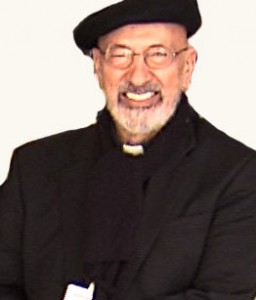 Â All the suffering we endure is united with Jesus, and the Blessed Mother guides our way. Â She is our mother and the power of her love is incredible. Â Ask her to come to you in your suffering as she came to her Son. She is our Our Mother of Hope and Compassion. Â God conquers sorrow with hope!
 All the suffering we endure is united with Jesus, and the Blessed Mother guides our way.  She is our mother and the power of her love is incredible.  Ask her to come to you in your suffering as she came to her Son. She is our Our Mother of Hope and Compassion.  God conquers sorrow with hope!
Hail, holy Queen, Mother of Mercy,
our life, our sweetness and our hope.
To thee do we cry, poor banished children of Eve;
to thee do we send up our sighs,
mourning and weeping in this valley of tears.Turn then, most gracious advocate,
thine eyes of mercy toward us;
and after this our exile,
show unto us the blessed fruit of thy womb, Jesus.
O clement, O loving, O sweet Virgin Mary.â„£ Pray for us O holy Mother of God,
â„Ÿ that we may be made worthy of the promises of Christ.
Msgr. John A. Esseff is a Roman Catholic priest in the Diocese of Scranton. He was ordained on May 30th 1953, by the late Bishop William J. Hafey, D.D. at St. Peter’s Cathedral in Scranton, PA. Msgr. Esseff served a retreat director and confessor to Blessed Mother Teresa.   He continues to offer direction and retreats for the sisters of the missionaries of charity around the world. Msgr. Esseff encountered St.  Padre Pio,  who would become a spiritual father to him. He has lived in areas around the world,  serving  in the Pontifical missions, a Catholic organization established by Bl. Pope John Paul II to bring the Good News to the world especially to the poor. Msgr. Esseff assisted the founders of the Institute for Priestly Formation and continues to serve as a spiritual director for the Institute. He continues to  serve as a retreat leader and director to bishops, priests and sisters and seminarians and other religious leaders around the world.  Â
To obtain a copy of Msgr. Esseff’s book byvisiting here
Be sure to visit Msgr. Esseff’s website “Building a Kingdom of  Love”
Tags: blessed virgin mary, confessor, Good News, our lady of sorrows, PA, retreat
This entry was posted on Saturday, September 15th, 2012 at 8:59 am
You can follow any responses to this entry through the RSS 2.0 feed.
I LOVE it…the birthday of the mother of all “moms”! Happy Birthday to the dearest Mother of all. The Church celebrates 3 birthdays on the calendar…Jesus, John the Baptist, and the great Mother of God, Mary Most Holy. We celebrate the day the Immaculate Conception was brought through birth into the world.  Â
From The Catholic News Agency –
“The Catholic Church will soon celebrate the birth of the Blessed Virgin Mary on its traditional fixed date of September 8, nine months after the December 8 celebration of her Immaculate Conception as the child of Saints Joachim and Anna.
The circumstances of the Virgin Mary’s infancy and early life are not directly recorded in the Bible, but other documents and traditions describing the circumstances of her birth are cited by some of the earliest Christian writers from the first centuries of the Church.
These accounts, although not considered authoritative in the same manner as the Bible, outline some of the Church’s traditional beliefs about the birth of Mary.
The “Protoevangelium of James,†which was probably put into its final written form in the early second century, describes Mary’s father Joachim as a wealthy member of one of the Twelve Tribes of Israel. Joachim was deeply grieved, along with his wife Anna, by their childlessness. “He called to mind Abraham,†the early Christian writing says, “that in the last day God gave him a son Isaac.â€
Joachim and Anna began to devote themselves extensively and rigorously to prayer and fasting, initially wondering whether their inability to conceive a child might signify God’s displeasure with them.
As it turned out, however, the couple were to be blessed even more abundantly than Abraham and Sarah, as an angel revealed to Anna when he appeared to her and prophesied that all generations would honor their future child: “The Lord has heard your prayer, and you shall conceive, and shall bring forth; and your seed shall be spoken of in all the world.â€
After Mary’s birth, according to the Protoevangelium of James, Anna “made a sanctuary†in the infant girl’s room, and “allowed nothing common or unclean†on account of the special holiness of the child. The same writing records that when she was one year old, her father “made a great feast, and invited the priests, and the scribes, and the elders, and all the people of Israel.â€
“And Joachim brought the child to the priests,†the account continues, “and they blessed her, saying: ‘O God of our fathers, bless this child, and give her an everlasting name to be named in all generations’ . . . And he brought her to the chief priests; and they blessed her, saying: ‘O God most high, look upon this child, and bless her with the utmost blessing, which shall be for ever.’â€
The protoevangelium goes on to describe how Mary’s parents, along with the temple priests, subsequently decided that she would be offered to God as a consecrated Virgin for the rest of her life, and enter a chaste marriage with the carpenter Joseph.
Saint Augustine described the birth of the Blessed Virgin Mary as an event of cosmic and historic significance, and an appropriate prelude to the birth of Jesus Christ. “She is the flower of the field from whom bloomed the precious lily of the valley,†he said.
The fourth-century bishop, whose theology profoundly shaped the Western Church’s understanding of sin and human nature, affirmed that “through her birth, the nature inherited from our first parents is changed.” – CNA
Tags: birth of the blessed virgin mary, blessed virgin mary, happy birthday, immaculate conception, Jesus, mary our mother, mother, mother of god, nativity of the blessed virgin mary, protoevangelium of james
This entry was posted on Saturday, September 8th, 2012 at 12:59 am
You can follow any responses to this entry through the RSS 2.0 feed.
Fr. James Kubicki, the director of the Apostleship of Prayer, Â shares insights of the Queenship of Mary
Tags: apostleship of prayer, blessed virgin mary, James Kubicki
This entry was posted on Wednesday, August 22nd, 2012 at 12:57 am
You can follow any responses to this entry through the RSS 2.0 feed.
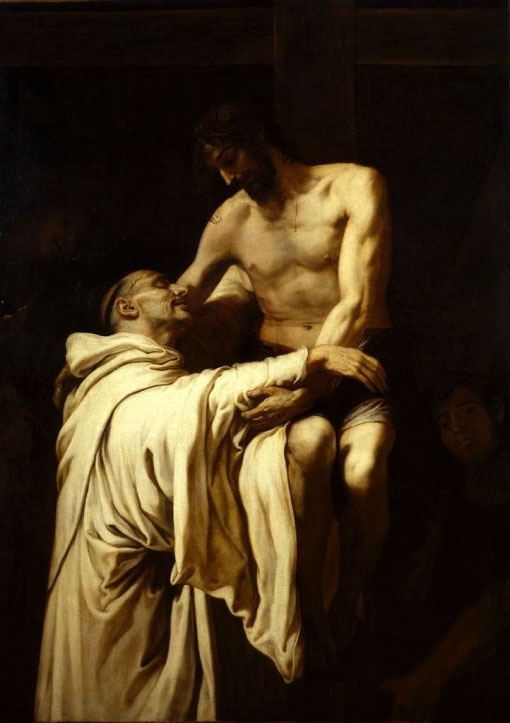 St. Bernard of Clairvaux, a great mystical doctor of the Church. What a heart for Jesus and the Blessed Virgin (I’m sure he still has).
St. Bernard of Clairvaux, a great mystical doctor of the Church. What a heart for Jesus and the Blessed Virgin (I’m sure he still has).
That is curiosity.
That is vanity.
–
That is love.”
St. Bernard of Clairvaux, was a Cisterian monk, who lived in France in the 12th century. Living at a time when the great gothic cathedrals where born, St. Bernard, advocated for simplicity and austerity in life. He was concerned about the temptations of worldly things and desires. He wished to focus solely on the love of Christ and the Blessed Mother; everything else was folly.
To read more about the details of his life you can visit here.
What captures my heart is his legacy of prayer and spiritual writings. He truly deserves the title Doctor of the Church. What a feast he has left us! Pope John Paul II has said that if we wish to learn to pray, look to the Mystical Doctors…he truly is one of those special souls. There is so much, where can one begin? Begin with Mary. Ask the Blessed Mother, she will lead you through his teachings.
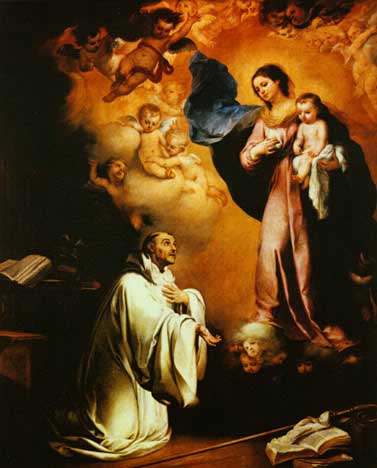 St. Bernard of Clairvaux composed the famous prayer to the Most Blessed Virgin Mary known as The Memorare
St. Bernard of Clairvaux composed the famous prayer to the Most Blessed Virgin Mary known as The Memorare
REMEMBER, O most gracious Virgin Mary, that never was it known that anyone who fled to thy protection, implored thy help, or sought thy intercession was left unaided. Inspired with this confidence, I fly to thee, O Virgin of virgins, my Mother; to thee do I come; before thee I stand, sinful and sorrowful. O Mother of the Word Incarnate, despise not my petitions, but in thy mercy hear and answer me. Amen.
St. Bernard on the Blessed Mother
St. Bernard on Holy Repentance
–
Highly recommended reading introduction to St. Bernard would be – “The Fulfillment of All Desire” by Ralph Martin
–
Tags: blessed mother, blessed virgin mary, Church, discerning heart, doctor of the church, emmaus road, holy repentance, intercession, love, monastic life, mystic, mystic of the Church, ralph martin, st bernard of clairvaux
This entry was posted on Monday, August 20th, 2012 at 12:40 am
You can follow any responses to this entry through the RSS 2.0 feed.
Holy Mary
From “Saints Speak”:
From heaven, in his own words, St. Alphonsus speaks on how the intercession of Mary is necessary for our salvation and shares the process of reviewing ones conscience before holy repentance..
Holy Repentance
Tags: blessed virgin mary, Holy Mary, holy repentance, repentance, st. alphonsus liguori
This entry was posted on Wednesday, August 1st, 2012 at 12:02 am
You can follow any responses to this entry through the RSS 2.0 feed.
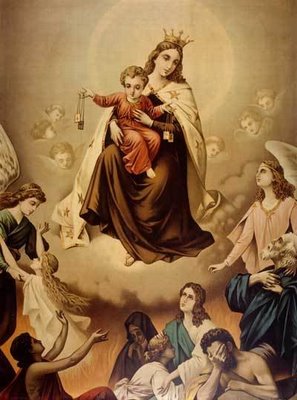 The Feast of Our Lady of Mount Carmel…
The Feast of Our Lady of Mount Carmel…
A prayer to Our Lady of Mt. Carmel
[powerpress]
from About.com
“According to the traditions of the Carmelite order, on July 16, 1251, the Blessed Virgin Mary appeared to St. Simon Stock, a Carmelite. During the vision, she revealed to him the Scapularof Our Lady of Mount Carmel, popularly known as the “Brown Scapular.” A century and a quarter later, the Carmelite order began to celebrate on this date the Feast of Our Lady of Mount Carmel.
The Carmelites had long claimed that their order extended back to ancient times-indeed, that it was founded on Mount Carmel in Palestine by the prophets Elijah and Elisha. While others disputed this idea, Pope Honorius III, in approving the order in 1226, seemed to accept its antiquity. The celebration of the feast became wrapped up with this controversy, and, in 1609, after Robert Cardinal Bellarmine examined the origins of the feast, it was declared the patronal feast of the Carmelite order.
The feast celebrates the devotion that the Blessed Virgin Mary has to those who are devoted to her, and who signal that devotion by wearing the Brown Scapular. According to tradition, those who wear the scapular faithfully and remain devoted to the Blessed Virgin until death will be granted the grace of final perseverance and be delivered from Purgatory early.”
I’m all about the cloth scapular rather than the medal or wood ones. It’s intent is to be a habit…who wears metal or wood clothing? I realize papal permission was given to wear the medal instead, but that was for missionaries in the jungle where the climate disintigrated the cloth quickly.  Really, would it really be a big problem, for those committed to the devotion, to wear the cloth scapular for solidarity sake?  Anyway…
Here are a few of the Carmelites dearest to our hearts:
Also THE SIXTEEN CARMELITE MARTYRS OF COMPIEGNE, but that’s tomorrow….
Tags: blessed virgin mary, brown scapular, catholic, catholic podcast, catholic prayer, cathollc spirituality, devotion, lady of mount carmel, Simon Stock
This entry was posted on Monday, July 16th, 2012 at 12:07 am
You can follow any responses to this entry through the RSS 2.0 feed.
Episode 16 – Seeking Truth with Sharon Doran, hosted by Bruce McGregor on his KVSS Â program “The Ninth Hour”. Â Ep 16 – The Virginity of the The Blessed Virgin Mary,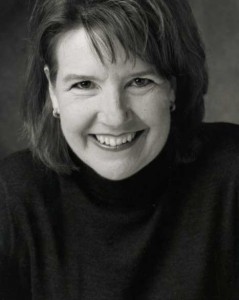
[powerpress]
Sharon Doran serves as the teaching director of “Seeking Truth.†An experienced Bible Study teacher, Sharon has a passion forscripture that will motivate and challenge you to immerse yourself in God’s Word and apply His message to your every day life.
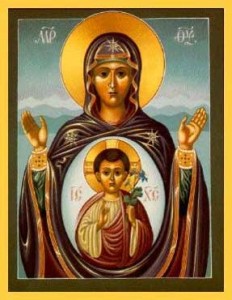 Episode 16 – Sharon and Bruce discuss the perpetual virginity of the Blessed Virgin Mary.  How is this possible? What is the significance of Mary’s silence after the annunciation? Why is the Virgin Birth so important?What do the Church Fathers have to say about this?  Where is all this found in Sacred Scripture?
Episode 16 – Sharon and Bruce discuss the perpetual virginity of the Blessed Virgin Mary.  How is this possible? What is the significance of Mary’s silence after the annunciation? Why is the Virgin Birth so important?What do the Church Fathers have to say about this?  Where is all this found in Sacred Scripture?
 “Seeking Truth†is an in depth Catholic Bible Study, commissioned by the Archdiocese of Omaha in response to John Paul II’s call to the New Evangelization as well as Pope Benedict XVI’s exhortation for all Catholics to study scripture. To learn more go to:www.seekingtruth.net
“Seeking Truth†is an in depth Catholic Bible Study, commissioned by the Archdiocese of Omaha in response to John Paul II’s call to the New Evangelization as well as Pope Benedict XVI’s exhortation for all Catholics to study scripture. To learn more go to:www.seekingtruth.net
Tags: blessed virgin mary, catholic, catholic podcast, catholic prayer, cathollc spirituality, church fathers, perpetual virginity, sacred scripture, Virgin Birth, virginity
This entry was posted on Wednesday, June 20th, 2012 at 3:48 am
You can follow any responses to this entry through the RSS 2.0 feed.
USCCA12- Episode 12-Â Â Mary: Â The Church’s First and Most Perfect Member
[powerpress]
Archbishop Lucas offers insights on the US Catholic Catechism for Adults Chapter 12:
The Second Vatican Council remains us that Mary is a member of the Church who “occupies a place in the Church which is the highest after Christ and also closest to us” (LG, no. 54).  She is the first and the greatest of all the disciples of Christ.
The Most Reverend George J. Lucas leads the Archdiocese of Omaha.Â
For other episodes in the visit our Archbishop George Lucas page
This programs is based on:
More information can be found here.
We wish to thank the USCCB for the permissions granted for use of  relevant material used in this series.
Also we wish to thank Fr. Ryan Lewis   for his vocal talents in this episode.
Tags: Archbishop Lucas, blessed virgin mary, catholic, catholic podcast, catholic prayer, cathollc spirituality, Church, Church's First, George Lucas, LG, united states catechism of the catholic church, USCCB
This entry was posted on Monday, May 21st, 2012 at 6:22 am
You can follow any responses to this entry through the RSS 2.0 feed.
[powerpress] Msgr. Esseff calls us to deeply ponder the role of the Blessed Virgin Mary during the Passion of Christ, but also in our own
during the Passion of Christ, but also in our own 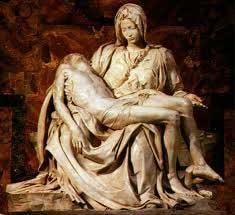 lives as well.
lives as well.
Be sure to visit Msgr. Esseff’s website: “Building a Kingdom of Love”
Tags: blessed virgin mary, catholic, catholic podcast, catholic prayer, cathollc spirituality, Esseff, holy saturday, John Esseff
This entry was posted on Saturday, April 7th, 2012 at 3:00 pm
You can follow any responses to this entry through the RSS 2.0 feed.
From Vatican Radio – It is a day to remember the Blessed Virgin’s “yes†to the Lord. On the Feast of the Annunciation, Catholics celebrate the angel Gabriel’s appearance to the Virgin Mary, announcing that she has been chosen to be the Mother of Our Lord. Usually celebrated on March 25th, the feast can be transferred to another date if it falls on a Sunday in Lent. This year, it is celebrated on Monday March 26th.
In the following reflection, Sr. Toni Harris, Justice and Peace promoter for the Dominican Sisters International, tells us how we, like Mary, can become witnesses to Christ in our every day lives…[powerpress = “Vatican_Radio”]
Tags: annunciation, Blessed Virgin, blessed virgin mary, catholic, catholic podcast, catholic prayer, cathollc spirituality, Dominican Sisters International, Monday March, reflection, Toni Harris, virgin mary
This entry was posted on Monday, March 26th, 2012 at 8:31 am
You can follow any responses to this entry through the RSS 2.0 feed.

